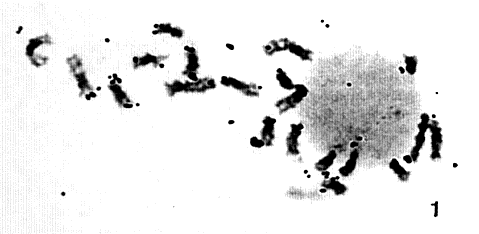34. Localization of a repetitive sequence, (CCCTAAA)II, at the ends of rice
chromosomes
Mei-Chu CHUNG1, Chii-Nien NING1, Tiyun WU2, Ray WU2 and Hsin-Kan
Wu1
1) Institute of Botany, Academia Sinica, Nankang, Taipei, Taiwan, R.O.C.
2) Biochemistry, Molecular & Cell Biology, 316 Biotechnology Building,
Cornell University, Ithaca, New York 14853, U.S.A.
Telomeres are the physical ends of eukaryotic chromosomes. Their
function may be involved in transient associations between chromosomes or in
replication of the ends of chromosomes (Zakian 1989). Due to the fact that
chromatin fiber ends are attached to the nuclear envelope (DuPraw 1970),
telomeres may also mediate movement of chromosomes during cell division. The
sequences of the repeat units are C\3\TA\3\ in Arabidopsis (Richards and
Ausubel 1988) and C\3\TTA\2\ in tomato (Ganal et al. 1991). The telomeric
sequences are tandem repeats, and the number of this simple repeated DNA at
individual telomeres can vary from as little as several units up to several
hundred units among species (Zakian 1989).
We have cloned and sequenced a telomere-like sequence form a rice
genomic library (Wu et al. 1993). A StyI-SpeI fragment from pOsTel-L1.4, was
isolated (Wu et al. 1993). This fragment included 11 repeat units of the
telomeric sequence, CCCTAAA, and was labeled with 3H-dNTPs by random
primers. The labeled fragment was used for in situ hybridization to
prometaphase chromosomes prepared from root tips of rice (cultivar IR36)
(Chung and Wu, 1987; Wu
Fig. 1 In situ hybridization to root tip cells of IR36 using a StyI-SpeI
fragment containing the (CCCTAAA)\11\ sequence as the probe. In this plate,
about 12 out of the 24 prometaphase chromosomes in a cell were labeled with
silver grains at either one or both ends. Note that only 19 chromosomes are
displayed, but no pericentric heterochromatin are labeled.

Fig. 2. In situ hybridization to root tip cells of IR36 using a PstI fragment
containing the (CCCTAAA)\11\ sequence as the probe. The probe is labeled with
digoxigenin (DIG) by using random primers, and the probe is hybridized to
rice prometaphase chromosomes. This plate is showin that almost all the ends
except that of the five chromosomes denoted by an arrow were labeled.

et al. 1991). In one experiment, 1,974 silver grains appeared on the
chromosomes in 60 analyzed cells. Among the silver grains, 72.3% (1,428)
were localized at the ends of the 12 pairs of chromosomes, whereas 12% (236)
went to the pericentric heterochromatin of the chromosomes. With respect to
individual arms, the end of the short arm of chromosome 10 had the least
grains, while the long-arm end of chromosome 4 had the most grains. It has
been suggested that the numbers of the telomeric repeats at individual
chromosomal ends may be different from each other. The two chromatid ends of
the prometaphase chromosomes were often labeled with one grain per end (Fig.
1).
When the plasmid pOsTel-L (Wu et al. 1993) was cut by the restriction
enzyme Pst1, labeled with digoxigenin (DIG) by using random primers, and in
situ hybridized to prometaphase chromosomes, most ends of the chromosomes
were labeled (Fig. 2). Out of these two methods, DIG labeling was superior
over that of 3H labeling.
References
Chung, M.C. and H.K. Wu, 1987. Karyotype analysis of IR36 and two trisomic
lines of rice. Bot. Bull. Acad. Sinca 28: 289-304.
DuPraw, E.J., 1970. DNA and Chromosomes. Holt, Rinehart and Winston, Inc.,
London.
Ganal, M.W., M.L.V. Lapitan and S.D. Tanksley, 1991. Macrostructure of
the tomato telomeres. The Plant Cell 3: 87-94.
Richards, E.J. and F.M. Ausubel, 1988. Isolation of a higher eukaryotic
telomere from Arabidopsis thaliana. Cell 53: 127-136.
Wu, H.K., M.C. Chung, T. Wu, C.N. Ning and R. Wu, 1991. Localization of
specific repetitive DNA sequences in individual rice chromosomes.
Chromosoma 100: 330-338.
Wu, T., S. Zhang, J. Xiao, H.K. Wu and R. Wu, 1993. Isolation and
characterization of a telomere-like sequence from rice. Rice Genetics
Newsletter, Volume 10.
Zakian, V.A., 1989. Structure and function of telomeres. Annu. Rev. Genet.
23: 579-604.

